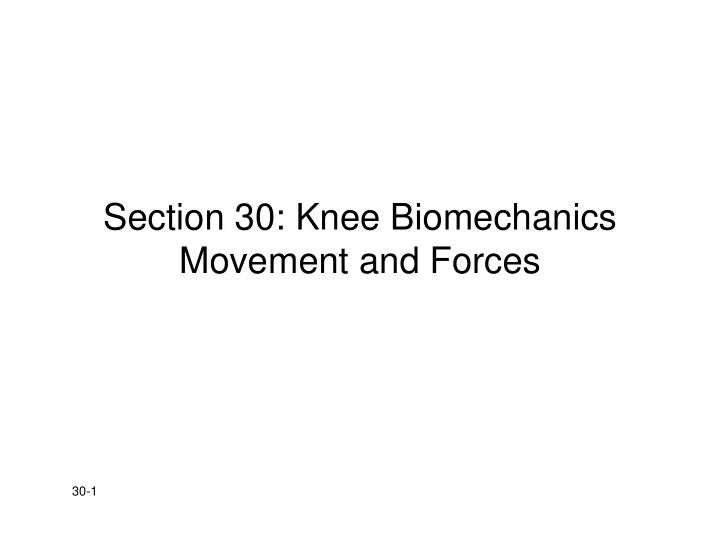

Section 30: Knee Biomechanics Movement and Forces 30-1
From: Iatridis 30-2
From: Iatridis 30-3
Joint Stability Dependent Upon Joint Stability Dependent Upon… • Bony congruence Bony congruence • Ligamentous structures – Ligaments Ligaments – Joint capsule – Meniscus Meniscus • Muscles – Flexibility Flexibility – Strength – Co-contraction Co contraction 30-4 From: Peeler
Ligaments Ligaments • Medial (tibial) collateral ( ) – 50% of max load in ext. – As knee flexes, loads shared by capsule, Ant and Post Cruciates • Lateral (fibular) collateral Lateral (fibular) collateral – 55% of max load in ext. – Loads increase as knee flexes because post. structures become lax lax • Anterior cruciate ligament – 75% max load in full ext. – 90% max load in full flex. 90% max load in full flex • Posterior cruciate ligament – Up to 100% load at 30° and 90° of knee flex. 30-5 From: Peeler
Special Tests Special Tests From: Scifers 30-6
Right Knee Right Knee Medial head of gastrocnemius muscle Tendon of semimembranosus semimembranosus muscle Anterior View Anterior View Posterior View Posterior View 30-7 From: Garner
From: Garner 30-8
From: Crosby 30-9
ACL Tears ACL Tears • Most common mechanisms M t h i – Contact: • CKC with foot ER w/ valgus stress CKC with foot ER w/ valgus stress • Hyperextension • direct hit on the posterior tibia – Non-Contact: – Non-Contact: • Most common • Due to sudden deceleration • Sudden landing cutting or pivoting • Sudden landing, cutting, or pivoting • Patient will c/o “buckling” or “giving away”, typically will hear and/or feel a “pop” 30-10 From: Scifers
Mechanism of Injury Mechanism of Injury • Trauma Trauma – Compression – Rotational Force – Valgus Force – Valgus Force – Usually Combination of Forces • Degenerative Changes – Greater than 30 years old G t th 30 ld – No PMHX required – Often due to MOI that “seemed harmless” at time harmless at time Noyes 2002 states 60% of meniscal injuries associated with ACL injury Noyes, 2002 states 60% of meniscal injuries associated with ACL injury 30-11 From: Scifers
From: Materials and Textiles 30-12
Recommend
More recommend